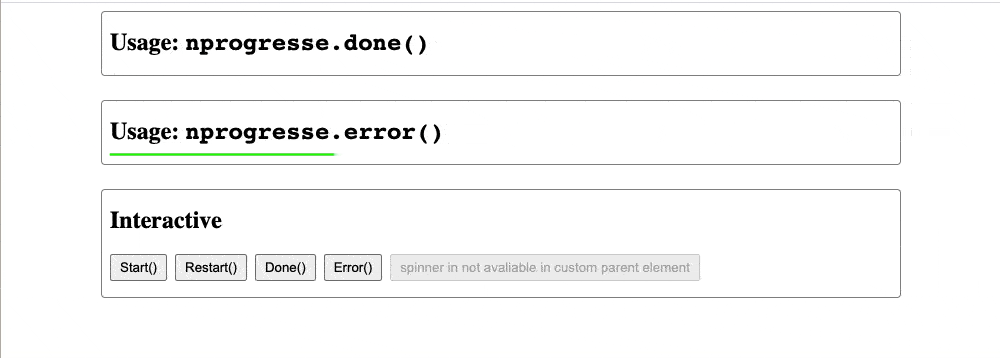Minimalist progress bar
See the original nprogress written by rstacruz, without whom this project wouldn't exist.
The last letter e is used for package name distinction, while the usages are almost the same, see the following.
Table of Contents
$ npm install --save nprogresseHere is an example code for basic usage.
Here is an example code for simple usage.
<!-- in standalone html -->
<script src="nprogresse/index.js"></script>
<link rel="stylesheet" href="nprogresse/style.css" />
<script>
window.NProgressE.start();
// time elapsed
window.NProgressE.done();
// or
window.NProgressE.error();
</script>Simply call start(), done() and error() to control the progress bar.
import NProgressE from 'nprogresse';
import 'nprogresse/style.css';
// start the progress
NProgressE.start();
// finish the progress in good status
NProgressE.done();
// finish the progress in error status
NProgressE.error();$(document).on('ajax:start', function () {
NProgressE.start();
});
$(document).on('ajax:end', function () {
if ('ajax:success') {
NProgressE.done();
} else {
NProgressE.error();
}
});-
Add progress to your Ajax calls! Bind it to the jQuery
ajaxStartandajaxStopevents.-
done()forajaxSuccesss. -
error()forajaxError.
-
-
Make a fancy loading bar even without Turbolinks/Pjax! Bind it to
$(document).readyand$(window).load.
Percentages
To set a progress percentage, call .set(n), where n is a number between 0..1.
NProgressE.set(0.0); // same as .start()
NProgressE.set(0.4);
NProgressE.set(1.0); // same as .done()Incrementing
To increment the progress bar, just use .inc(). This increments it with a random amount. This will never get to 100%: use it for
every image load (or similar).
NProgressE.inc();If you want to increment by a specific value, you can pass that as a parameter:
NProgressE.inc(0.2); // This will get the current status value and adds 0.2 until status is 0.994Force-done
By passing true to done(), it will show the progress bar even if it's not being shown. (The default behavior is that .done() will not
do anything if .start() isn't called)
NProgressE.done(true);Force-error
By passing true to error(), it will show the progress bar even if it's not being shown.
NProgressE.error(true);Get the status value
To get the status value, use .status.
console.log(NProgressE.status);Get the progress element
To get the element, use .el;
console.log(NProgressE.el);Changes the minimum percentage used upon starting, (default: 0.08).
NProgressE.configure({ minimum: 0.1 });You can change the markup using template. To keep the progress
bar working, keep an element with role='bar' in there. See the default template for reference.
NProgressE.configure({
template: "<div class='....'>...</div>",
});Adjust animation settings using easing (a CSS easing string) and speed (in ms), (default: ease and 200).
NProgressE.configure({ easing: 'ease', speed: 500 });Turn off the automatic incrementing behavior by setting this to false. (default: true)
NProgressE.configure({ trickle: false });Adjust how often to trickle/increment, in ms.
NProgressE.configure({ trickleSpeed: 200 });Turn on loading spinner by setting it to true, (default: false).
NProgressE.configure({ showSpinner: true });Specify this to change the parent container, (default: body).
NProgressE.configure({ parent: '#container' });Modify the built style.css to your liking.
The included CSS file is pretty minimal.
Tip: you probably only want to find source less file here.
In fact, feel free to scrap it and make your own style!




